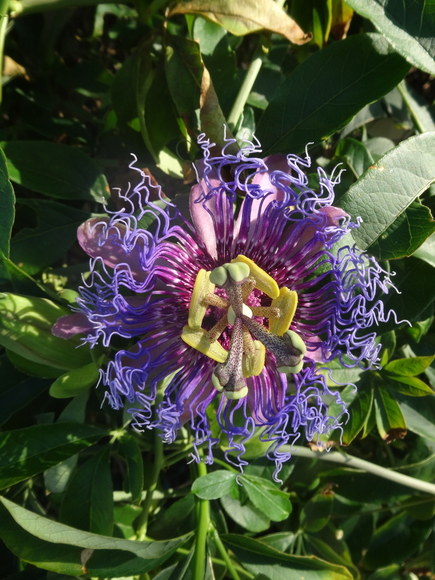A Passion for Passionflowers in Prose & Poetry
by Devon Higginbotham / Poem by Donna Bollenbach
Suncoast Native Plant Society
 |
| The Passionflower...it looks like it must be from another planet. _D Higginbotham |
The first time I saw a passion flower, with its bizarre,
lavender zigzaggy petals and yellow-star stamens, my immediate thought was it
must be from another planet. It looks like no other flower shape — daisy, tulip
or rose.
Not only is it spectacular to behold but it’s huge,
measuring about 4 inches across, and it smells like a sorority house on formal
night.
I had to have one!
Sometimes called the maypop or May apple, this perennial
vine is native to Florida and the southeastern United States. It grows well in
zones seven to 10, climbing on fences trellises or as a ground cover in sunny
locations. It spreads underground, sending out shoots some distance from the
parent plant. It is attractive to zebra longwing and gulf fritillary larvae,
which keep it in check. Thus, supplying your garden with a steady stream of
butterflies.
Just when you think you’ve found the perfect garden plant,
one of your flowers will go to seed, yielding a 2- to 3-inch passion fruit,
which taste much like a crunchy kiwi when ripe.
 |
| Gulf fritillary caterpillar_D Higginbotham |
For those of you living in dry areas, coastal beaches or
dune communities, the passion vine will prosper along with your sea oats, saw
palmettos and seaside goldenrod. Mine sprawls across a picket fence, gets
watered when it rains and is not particularly fond of being over-watered.
The passion vines have special glands that produce nectar at
the base of the leaves which attract ants. The ants roam all over the plants
and carry away butterfly eggs or young caterpillars they find. But with a few
gulf fritillaries flitting about laying eggs, the butterflies keep up a steady
supply of larvae, and some manage to elude the ants to grow to maturity.
 |
| Cross, nails & crown of thorns?_D Bollenbach |
The theory was the three stigmas represent the three nails
used on the cross, the five anthers count the wounds in Jesus, the corona of
the flower recalls the crown of thorns, the ten petals equal the disciples
(minus Paul and Judas) and the whip-like tendrils represent the whips used on
Jesus, thus, the “Passion of Christ.”
Whatever your theory on Linnaeus’ mindset so long ago, the
passion vine is a plant any Florida gardener would be passionate about.
Read Devon's entire article published in the Plant City Observer here.
Read Devon's entire article published in the Plant City Observer here.
______________________________________________
Ten Ways of Looking at a Passionflower
BY DONNA BOLLENBACH
I
Among a thousand bees,
The only fragrance they desire
Is the passionflower's.
II
I was of three hearts,
Like a vine,
In which there are three passion flowers.
III
The scent of the passion flower fills the meadow.
The bees and butterflies dance together.
IV
A bee and a butterfly
Are one,
A bee and a butterfly and a passion flower
Are one.
V
I do not know which I prefer
The complexity of the flower
Or the complexity of the vine
The passion flower in bloom
Or the fruit left behind.
VI
The butterfly lays its eggs,
In the shadow of the passionflower
The caterpillar cuts swaths
Through the leaves,
It is sacrificial love.
VII
At the sight of a thousand passion flowers
Growing in the meadow,
The pauper and the king
Are equal.
VIII
The worker bees lie drunk
In the purple fringes of the passionflower
While the queen paces the hive.
IX
The passionflower spreads its vines,
Tracing many paths
Through the meadow.
X
The bees are buzzing.
The passionflower must be blooming.




Comments